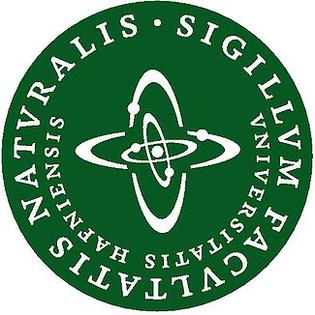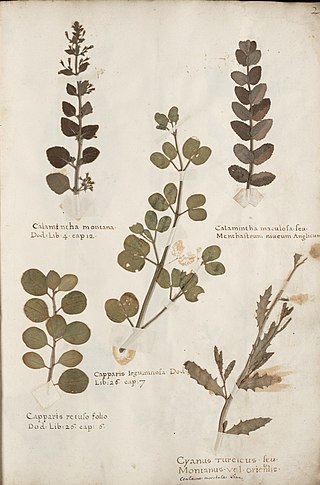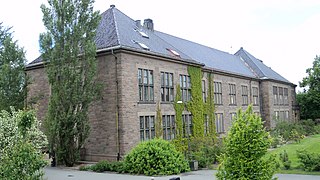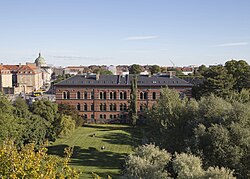
The Faculty of Science at the University of Copenhagen houses 12 departments, including the Natural History Museum of Denmark. The faculty also encompasses several national and international research centres, and has a number of field stations in Denmark and Greenland, among them the university's Arctic Station in central West Greenland. The faculty's administration is housed at the university's Frederiksberg Campus.

A herbarium is a collection of preserved plant specimens and associated data used for scientific study.

Johannes Japetus Smith Steenstrup FRS(For) HFRSE was a Danish zoologist, biologist, and professor.

The University Botanical Garden is Norway's oldest botanical garden. It was first established in 1814 and is administered by the University of Oslo. It is situated in the neighborhood of Tøyen in Oslo, Norway.

Peter Wilhelm Lund was a Danish Brazilian paleontologist, zoologist, and archeologist. He spent most of his life working and living in Brazil. He is considered the father of Brazilian paleontology as well as archaeology.

The University of Copenhagen Botanical Garden, usually referred to simply as Copenhagen Botanical Garden, is a botanical garden located in the centre of Copenhagen, Denmark. It covers an area of 10 hectares and is particularly noted for its extensive complex of historical glasshouses dating from 1874.

The Goulandris Museum of Natural History is a museum in Kifisia, a northeastern suburb of Athens, Greece. It was founded by Angelos Goulandris and Niki Goulandris in 1965 in order to promote interest in the natural sciences, to raise the awareness of the public, in general, and in particular to call its attention to the need to protect Greece's natural wildlife habitats and species in the danger of extinction.
The Centennial Museum and Chihuahuan Desert Gardens is a cultural history and natural history museum on the campus of the University of Texas at El Paso in El Paso, Texas, United States.The museum was built in 1936 to commemorate the centenary of Texas independence, making it the oldest museum in El Paso.

The Finnish Museum of Natural History, established in 1988, is a research institution under the University of Helsinki in Finland, based in Helsinki, Finland. It is a natural history museum responsible for the national botanical, zoological, geological and paleontological collections, which consist of samples from around the world. The collections serve scientific, public informational and educational purposes.

The NTNU University Museum in Trondheim is one of seven Norwegian university museums with natural and cultural history collections and exhibits. The museum has research and administrative responsibility over archaeology and biology in Central Norway. Additionally, the museum operates comprehensive community outreach programs and has exhibits in wooden buildings in Kalvskinnet.

The Natural History Museum of the University of Pisa, located in the city of Pisa in Tuscany, Italy, is a renowned institution dedicated to the study and display of natural history. The museum is home to one of the largest collections of cetacean skeletons in Europe, showcasing an impressive array of marine mammal specimens. In addition to its extensive cetacean holdings, the museum's oldest collections include seashells amassed by the Italian invertebrate scientist, Niccolò Gualtieri. Serving as both an educational and research institution, the museum invites visitors and scholars to explore the diversity and complexity of the natural world.
The Georgia Museum of Natural History is the U.S. state of Georgia's museum of natural history located in Athens, Georgia. The museum has eleven different collections in Anthropology, Arthropods, Botany, Geology, Herpetology, Ichthyology, Invertebrate, Mammalogy, Mycology, Ornithology, and Zooarchaeology. In addition, there are exhibitions, archives, and entertainment for children. The Exhibit Gallery is free and open to the public during scheduled hours. People can schedule a tour to visit the collections by appointment.

The Natural History Museum at the University of Oslo is Norway's oldest and largest museum of natural history. It is situated in the neighborhood of Tøyen in Oslo, Norway.

The Copenhagen Zoological Museum was a separate zoological museum in Copenhagen, Denmark. It is now a part of the Natural History Museum of Denmark, which is affiliated with the University of Copenhagen. The separate museum location closed in 2022, but will reopen in 2025 in new and considerably larger buildings in the northeastern corner of the Copenhagen Botanical Garden. Although the museum will be relocated, the research and storage facilities at its old location have been maintained.

The City Campus is one of the University of Copenhagen's four campuses in Copenhagen, Denmark. It is home to the Faculty of Social Sciences and parts of the Faculty of Health and Medical Sciences and the Faculty of Science. The main campus area, the Center for Health and Society, is situated on Øster Farimagsgade, across the street from the University's Botanical Garden, which is also part of the campus area. The City Campus also comprises a building on Øster Voldgade and the university headquarters on Frue Plads.

A scientific collection is a collection of items that are preserved, catalogued, and managed for the purpose of scientific study.
Science Museums, Aarhus, founded 1 January 2008, is an umbrella organization comprising the Steno Museum, the greenhouses at Aarhus Botanical Gardens, the Ole Rømer Observatory and a herbarium in Aarhus, Denmark. The Science Museums works as an independent institution under the Science and Technology department of Aarhus University.

The Geological Museum was a separate geology museum at the northeast corner of the Copenhagen Botanical Garden, in Copenhagen, Denmark. Although its location remains the same and the main exhibits have been maintained, it is now part of the Natural History Museum of Denmark rather than a separate museum. In addition to housing exhibits, it also facilitates research and study as part of the University of Copenhagen, with some of the museum staff actively partaking in research worldwide.
The UCPH Department of Biology is a department under the Faculty of Science at University of Copenhagen (UCPH). It is organized in 10 sections and is also involved in a number of research centres. The department offer three BSc and four MSc degree programmes. With 400 employees and 1,800 students, it is the largest department at the faculty. It also operates the Øresund Aquarium in Helsingør.




















